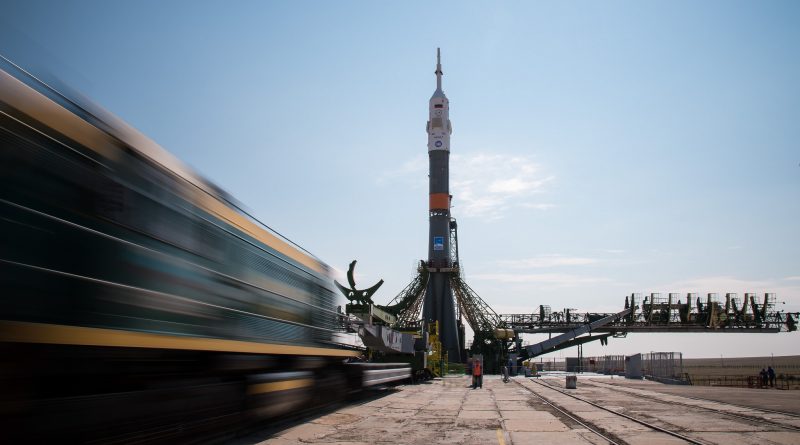Upgraded Soyuz to Ferry three to Space Station in Extended Orbital Link-Up
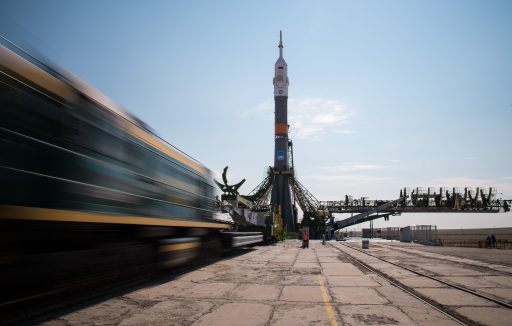
Set for a two-day commute to their orbital workplace, an international crew trio is ready for liftoff aboard their Soyuz spacecraft in the early hours on Thursday to head into orbit for a four-month stay aboard the International Space Station.
Second-time Soyuz flier and first-time commander Anatoli Ivanishin will be joined by space rookies Takuya Onishi and Kate Rubins when lifting off atop a Soyuz FG rocket. Departing from the historic Site 1/5 at the Baikonur Cosmodrome, Soyuz FG will fly to the north-east to deliver the Soyuz MS-01 spacecraft to a Low Earth Orbit less than nine minutes after its 1:36 UTC liftoff, marking the start of the first flight of the modified series of Soyuz spacecraft.
Taking the scenic route, the mission will stick to the 34-orbit rendezvous – flying for two days to reach its destination in space instead of the more comfortable four-orbit rendezvous that has become the norm for crewed flights to ISS. Typically, Soyuz missions have to revert to a two-day rendezvous profile when orbital geometry does not permit a fast-track rendezvous or in case of problems during flight.
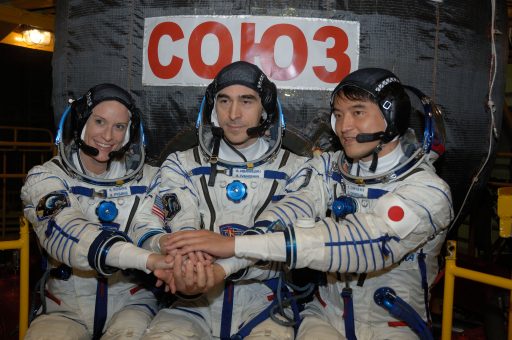
The two-day profile was chosen for Soyuz MS-01 to provide time for testing of the newly introduced systems part of the MS upgrade of the vehicle.
Russia’s space program has the big advantage of flying two very similar spacecraft for cargo and crew missions, allowing changes first to be demonstrated on the unpiloted Progress vehicle before being introduced on the crew vehicle. Two Progress MS spacecraft have flown with no issue, but the first Soyuz MS mission will still perform a testing campaign to ensure the new systems are functioning as planned in an operational environment.
The MS upgrade is primarily focused on the spacecraft’s Navigation, Control and Communications systems, highlighted by the introduction of a new Unified Telemetry and Command System. Soyuz MS has the capability of communications with the ground through the Luch data relay satellites in Geostationary Orbit, allowing crews to stay in touch with mission control for the majority of their treks around Earth instead of only having brief periods of contact on half of their daily orbits.
>>Soyuz MS Spacecraft Overview
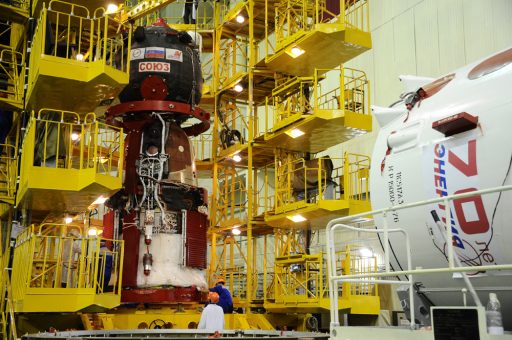
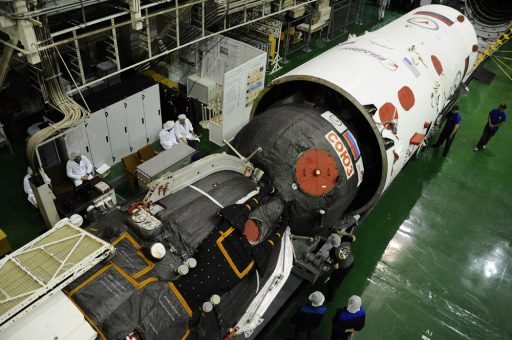
Soyuz MS features satellite navigation for orbit determination, an improved KURS rendezvous system, a new proximity communications link for relative navigation with ISS, more powerful solar arrays, a new thruster arrangement and an additional drive mechanism in its docking system – all to make the spacecraft more robust and adding new capabilities.
Riding aboard the first Soyuz MS spacecraft are three international crew members, Commander Anatoli Ivanishin, Takuya Onishi of JAXA and NASA’s Kate Rubins.
Ivanishin comes from a military background, serving as a pilot in the Russian Air Force before applying to become a Cosmonaut in 1997, only to be rejected because he was too tall to fly on the Soyuz spacecraft.
His selection came in 2003 after the Soyuz TMA version was introduced with a modified seating arrangement, increasing the maximum allowable height of its passengers. He logged 165 days in space as part of one previous mission, living and working aboard ISS for Expeditions 29/30 in 2011/12.
Takuya Onishi worked in commercial airline operations, first in passenger service before completing flight training to become a pilot on the Boeing 767. The Japanese Aerospace Exploration Agency selected him in 2009 and Onishi trained at the Johnson Space Center alongside NASA’s 20th Astronaut Group.
Kate Rubins holds a Ph.D. in Cancer Biology and completed extensive research in the field of microbiology, focused on different viral diseases. Her work included several trips to Africa to study viruses particularly affecting this area of the world. NASA selected her in 2009 and, after extensive flight training, Rubins received her ISS crew assignment in 2014.
As can be expected with her background, she looks forward to conducing biological research aboard the Space Station with a recent expansion of the scientific repertoire to include in-orbit DNA sequencing.
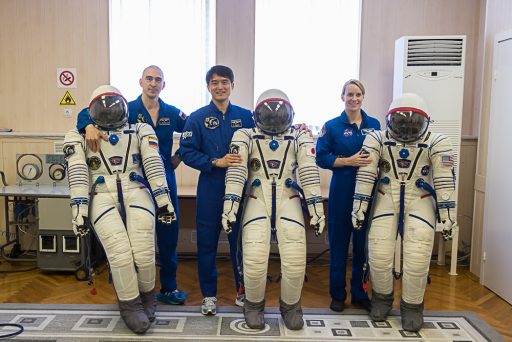
The crew’s ride to space – a 49.5-meter tall Soyuz FG rocket – was wheeled to the historic launch pad at Site 1/5 on Monday to begin two days of final preparations for its ride into orbit with the 7,200-Kilogram Soyuz MS-01 spacecraft.
The three crew members have been at the Baikonur Cosmodrome since June 24 to complete a final training campaign to conclude over two years of flight-specific training operations that took each crew member several times around the globe.
With launch day approaching, the crew participated in final meetings with Mission Control and they tagged up with their colleagues in orbit – Jeff Williams, Alexey Ovchinin and Oleg Skripochka who’ve had the Station to themselves since May 18 and are looking forward to welcoming the new crew members on Saturday.
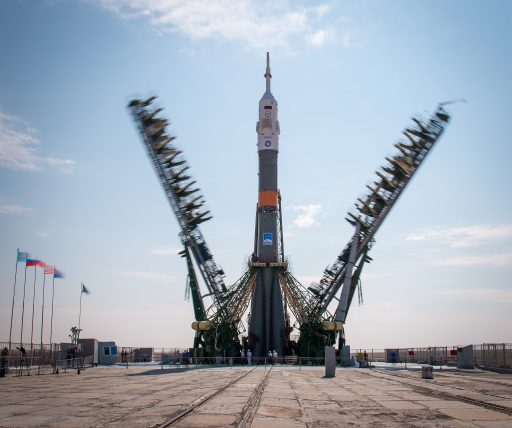
Over five decades of human spaceflight operations have left their mark at the Baikonur Cosmodrome where crews and engineers adhere to many traditions dating back to the early days of sending crews into orbit. Part of the tradition is the blessing given to the Soyuz rocket by an Orthodox Priest the day before launch, the formal approval of the prime crew by the State Commission on the eve of liftoff and many more commemorative activities coming on the day of launch.
When Soyuz countdown operations begin around eight hours ahead of liftoff out at Site 1/5, the crew will already be awake to begin their final preparations to leave the planet for the almost half a year. They will take their seats atop 274 metric tons of explosive rocket fuel with about two hours to go, counting down to an early summer morning liftoff.
Rising from its launch pad under the loud thunder of its four-liquid fueled boosters and core stage, Soyuz will swing to the north-east to deliver the crew into the orbital plane of the Space Station. The force of raw rocket power will transition to the sensation of weightlessness eight minutes and 45 seconds after liftoff when Soyuz MS and its crew trio arrive in orbit.
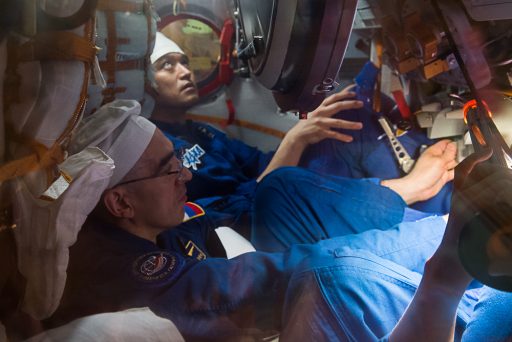
The crew will be set for a two-night stay in the confined space of the Soyuz spacecraft, moving into the Orbital Module shortly after arriving in space. A pair of engine burns is planned for their first day in orbit with another to follow on Friday, though free time will be sparse as the crew has to put the new Soyuz MS systems to the test before arriving in the vicinity of the Space Station on Saturday.
Back in their seats inside the Entry Module, the crew hopes to oversee a fully automated docking to the Earth-facing Rassvet module, planned for 4:12 UTC on Saturday.
The joint Expedition 48 crew will be gearing up for a busy mission supporting a packed scientific program in the station’s laboratory modules, overseeing the arrival of a Progress spacecraft and the SpaceX Dragon and completing one, possibly two, spacewalks to prepare the Station for the start of Commercial Crew Traffic. (Expedition 48 Preview)
Countdown & Launch Profile
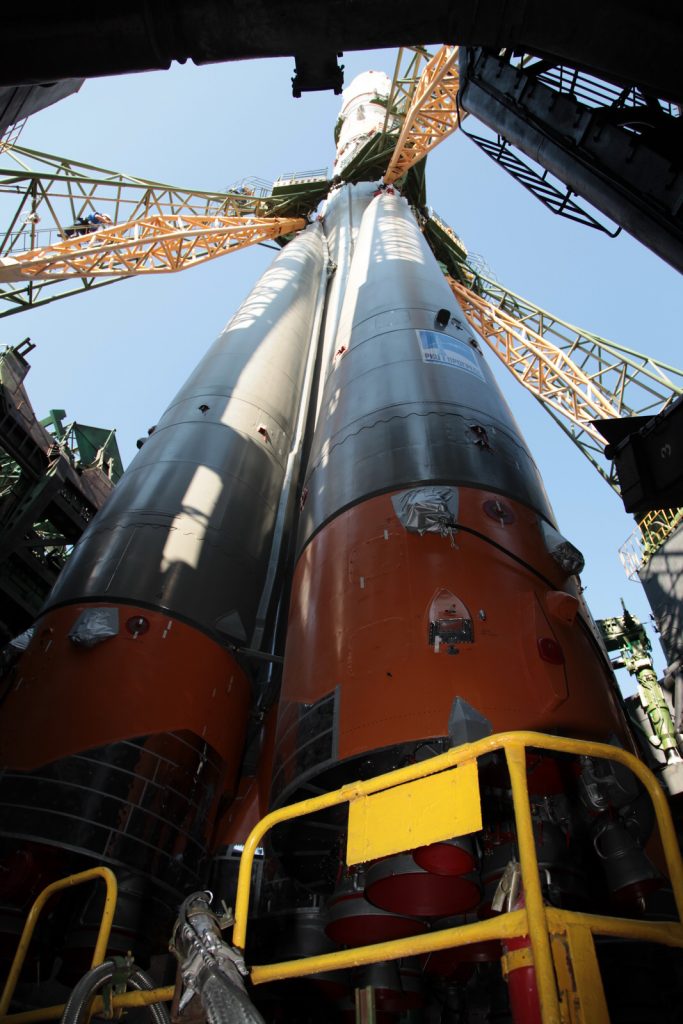
The three crew members will wake up about nine hours ahead of their liftoff in a schedule that is adjusted slightly given the changed in flight-schedule of the two-day versus six-hour mission profiles. Waking up, the crew members can enjoy their final shower in the comforts of gravity and breakfast at the Cosmonaut Hotel before boarding the bus to the Cosmodrome’s Site 254 around T-6 hours.
At Site 254, the three crew members go through a final medical check before ingressing their Sokol Launch and Entry suits under assistance by suit technicians to ensure the Sokols can fulfill their task of protecting the crew in the event of a sudden cabin depressurization. Leak checks will be completed by each crew member, one by one, giving the other two a chance to have a face-to-face conversation with family and friends inside the press room.
Out at Site 1/5, engineers will initiate the countdown sequence around eight hours prior to launch with the final set of fueling preparations. Once the two vehicles are activated, the Soyuz rocket and spacecraft complete a series of checkouts – communication checks, electrical testing and propulsion system testing is performed in the early stages of the countdown. Completing final hands-on work on the launch vehicle, engineers will install batteries in the booster and remove protective covers before standing by to receive a GO for propellant loading.
Five hours and 30 minutes ahead of launch, the Russian State Commission will meet to look at the overall status of the countdown and the results of launch vehicle and spacecraft testing to provide official approval for the beginning of the Soyuz propellant loading sequence. By that time, the tanking carts will have already been rolled up to the pad and hooked up to Ground Support Equipment used to deliver propellants to the Soyuz launch vehicle, loaded via the various umbilical masts connected to the different stages of the rocket to deliver propellant, pressurant and electrical connectivity.
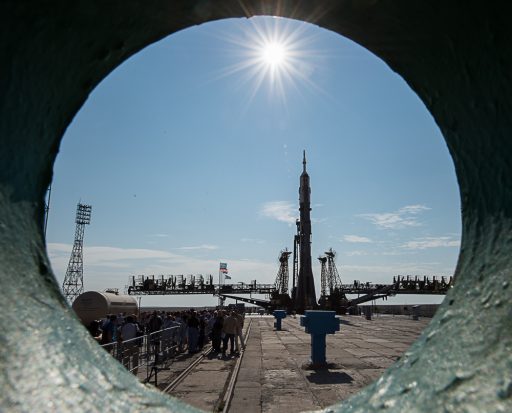
Soyuz FG stands 49.5 meters tall and weighs 305,000 Kilograms when fully fueled. It can lift up to 7,200 Kilograms into Low Earth Orbit using a two-stage stack plus four liquid-fueled boosters clustered around the Core Stage.
Each of the boosters is 19.6m long consisting of a tapered and a cylindrical section with a maximum diameter of 2.68m and a launch mass of 43,410 Kilograms. Each booster is powered by an RD-107A engine delivering 838.5kN of sea level thrust.
The Core Stage is ignited with the boosters and continues to burn after the boosters separate, acting as first and second stage. It is 27.8m tall and 2.95 meters in diameter with a total launch mass of 99,500kg. The core is powered by a 990-Kilonewton RD-108A engine and four verniers for vehicle control. Sitting atop the Core Stage is the third stage that is 6.74m long, 2.66m in diameter and weighs 25,300 Kilograms powered by a four-chamber RD-0110 engine with four vernier thrusters for vehicle control.
Over the course of a two-hour sequence beginning just inside L-5 hours, the boosters, the large Core Stage and the third stage are loaded with a total of 274,140 Kilograms of refined Kerosene and –183°C Liquid Oxygen. Additionally, the boosters and core stage will receive liquid Nitrogen to be heated during flight in order to pressurize the propellant tanks. The boosters and core stage also contain Hydrogen Peroxide that is used to drive the turbopumps of the engines.
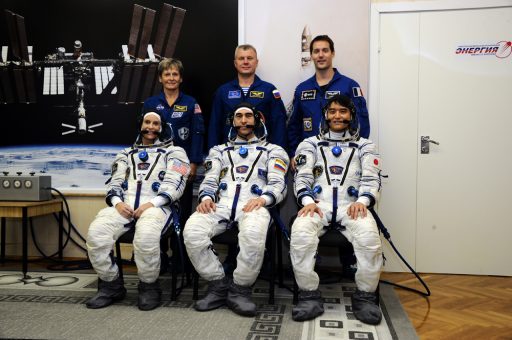
Around L-3 hours, the crew will depart Site 254, reporting to officials and boarding a bus adorned with plenty of horseshoes for good luck. A 20-minute bus ride will take the trio to Site 1/5 where their Soyuz will be waiting and where the history of crewed space flight began over five decades ago with the launch of Yuri Gagarin.
Getting off their bus, the crew members will have a look at their fully fueled rocket, take a few photos with officials present at the pad and walk over to the Service Structure stairs to wave good-bye and enter the elevator taking them up to their Soyuz for crew ingress.
Climbing into the Soyuz through a hatch inside the Launch Shroud, the crew members will – one by one – enter the Orbital Module through its side hatch before climbing down through the Entry Module’s hatch to reach their Kazbek seat liners in the confined space of the small spacecraft that the crew has to share with cargo and equipment.
Leak checks on the spacecraft pick up as soon as Soyuz has been sealed off and the crew will begin working through their pre-launch checklist that will take them about one hour to complete.
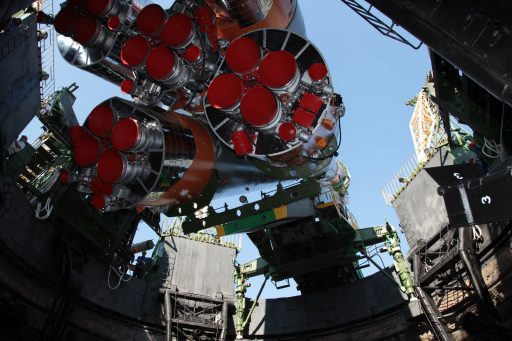
60 minutes ahead of launch, the Guidance System is activated and the flight computers receive their flight software 15 minutes later. As hands-on work at the pad wraps up, teams will retract the two halves of the Soyuz Service Structure at L-40 minutes and put all ground systems in a safe configuration. Half an hour before T-0, the Launch Abort System will be activated and switched to automatic mode. The pad will be clear by L-15 minutes.
14 minutes ahead of launch, the Soyuz spacecraft is transferred to battery power and at L-10 minutes, the Soyuz FG inertial guidance system is configured for flight as gyros are uncaged and flight recorders are activated. Entering the Automated Countdown Sequence at T-6 minutes, the Soyuz launch vehicle will begin its final reconfigurations as part of a highly choreographed procedure.
Soyuz telemetry systems are activated at T-5 minutes and the Commander Controls inside the Soyuz become active. At that point, the crew members will have closed their helmets and switched to suit air.
Three minutes before launch, the five engines of the boosters and core stage are purged with nitrogen before propellant tank pressurization starts at T-2:35. Transfer to internal power occurs one minute before liftoff and Soyuz enables its Auto Sequencer that controls the final countdown events. The third stage umbilical is disconnected at T-50 seconds and the service tower retracts ten seconds later. At T-25 seconds, the umbilical tower of the Core Stage is moved to its launch position.
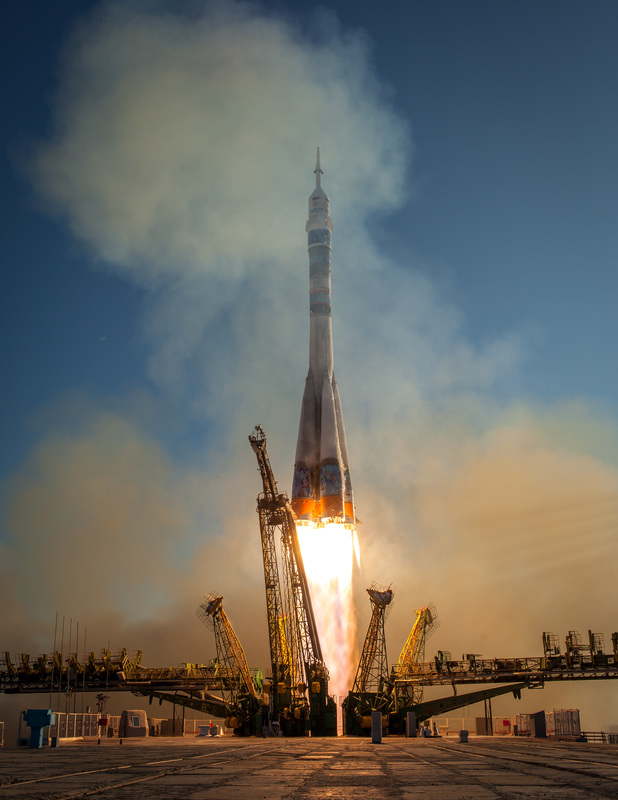
With the Auto Sequencer in control of the countdown, the Soyuz starts its ignition sequence at T-20 seconds as the turbopumps of the booster and core stage engines soar to flight speed and the engines reach an intermediate thrust level before being throttled up to full thrust for liftoff.
Blastoff is set for precisely 1:36:41 UTC, the optimized launch time based on the latest tracking data of the International Space Station. Soyuz has a ten-second launch window to permit the vehicle to link up with the space station. As clocks hit zero, Soyuz will begin rising from its launch pad with a total launch thrust of 422 metric tons, embarking on a nine-minute ascent mission following the usual flight profile.
Soyuz FG passes through Maximum Dynamic Pressure and Mach 1 a little over 70 seconds into the flight, being powered by the RD-107A engines of the boosters and the RD-108A of the core. The Launch Abort System jettisons its Escape Tower at 114 seconds into the mission, marking the transition from low- to mid-altitude abort modes in a system that provides launch abort capability all the way to orbital insertion. The four boosters and their RD-107A engines will burn for 1 minute and 58 seconds consuming a total of 39,600kg of propellants to provide extra boost to the vehicle. After shutdown at an altitude of 49 Kilometers, the boosters are jettisoned for a crash landing 348 Kilometers downrange.
With the boosters tumbling away from the Soyuz rocket, propulsion will only be provided by the Core Stage’s engine, delivering a thrust of 94,400 Kilogram-force. Two minutes and 33 seconds after launch, Soyuz will be over 80 Kilometers in altitude and jettison its protective Launch Shroud giving the crew a view outside through their small Entry Module windows, but the crew members will be focused on their displays, tracking the progress of their ascent into orbit.
Four minutes and 45 seconds into the flight, the Core Stage will shut down its engine, marking the beginning of the hot staging sequence. Two seconds after cutoff, the third stage’s RD-0110 engine will be commanded to ignite. At the same time, pyrotechnic bolts in the interstage will be fired to severe the connection between the empty Core Stage and the upper stage of the Soyuz that will continue powered ascent while the core heads towards re-entry and impact 1,570 Kilometers downrange from the launch site.
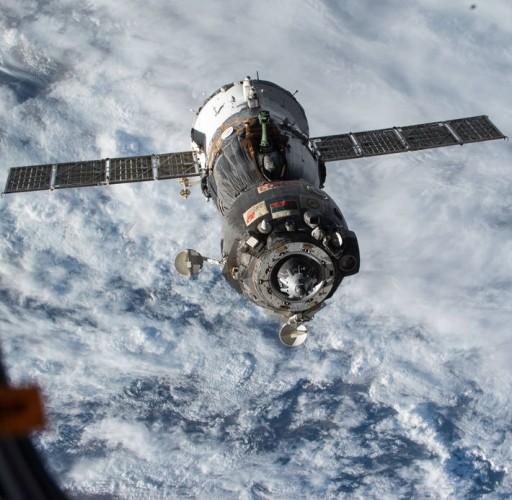
The third stage will fire its four-chamber engine and four gimbaling verniers for vehicle control until T+8 minutes and 45 seconds to achieve the planned insertion orbit. Just over two seconds after engine shutdown, the Soyuz spacecraft will separate from its rocket stage which itself will open up an oxygen valve to move away from the spacecraft.
Following spacecraft separation, the Soyuz will put a series of pre-programmed commands into motion to deploy its two power-generating solar arrays and KURS antennas.
Immediately after spacecraft separation, Soyuz MS-01 will go through a series of systems checks, pressurize its propulsion system manifolds and enter a stable three-axis orientation. Mission Control will complete a status check and provide the crew with a GO to open their helmets and get out of their seats to ingress the orbital module.
Since Soyuz MS-01 uses the conventional two-day approach to ISS, the timeline for the crew will not be as packed as it would be for the four-orbit rendezvous. After a series of initial reconfigurations to transition the Flight Control System from launch mode to its free flight configuration, the crew members will get out of their Sokol launch and Entry Suits and set up the orbital module for their two-day commute to the Space Station.
Soyuz MS-01 will receive an update on its orbital parameters during the mission’s first ground station pass following the completion of the first orbit. During the third orbit of the mission, Soyuz will conduct a pair of engine burns, separated by about half an orbit, aiming for an orbit of 279 by 305 Kilometers to place the Soyuz in the proper orbit to catch up with the Space Station. Another engine burn will take place during the 17th orbit of the mission to put the Soyuz in the appropriate orbit taking it to a position from where it can enter its Automated Rendezvous Sequence.
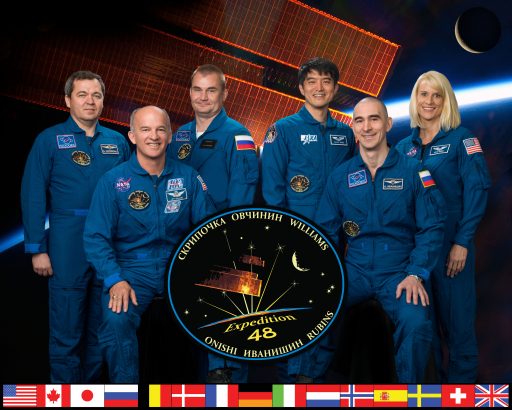
The Automated Rendezvous Sequence will be initialized at 01:51 UTC on Saturday. During the Rendezvous Sequence, the Soyuz will complete more engine burns to link up with the Space Station. A two-way voice and proximity communications link between ISS and Soyuz will be established and the Space Station will hand to Russian Attitude Control.
Performance of the KURS radio navigation system will be verified as part of the standard short test to make sure the system is providing good navigation data to the Soyuz. Once entering the vicinity of ISS, the Soyuz activates its TV system and performs a number of rendezvous impulses with its small DPO thrusters to get ready for the Flyaround Sequence starting at a range of 400 meters at 7:49 UTC.
Making a slow lap around ISS, Soyuz MS-01 will line up with the Rassvet Module. At a distance of 180 meters, the approach will be stopped for a short period of Stationkeeping to give mission controllers a chance to verify good alignment and perform a short systems check.
Once the command for final approach is sent, the Soyuz fires its DPO thrusters to initiate a gentle closing rate. During final approach, Soyuz retracts one of its KURS antennas and keeps itself aligned with the docking port. Contact & Capture is expected at 4:12 UTC (+/-3 minutes) after what is hoped to be a fully automated approach..

